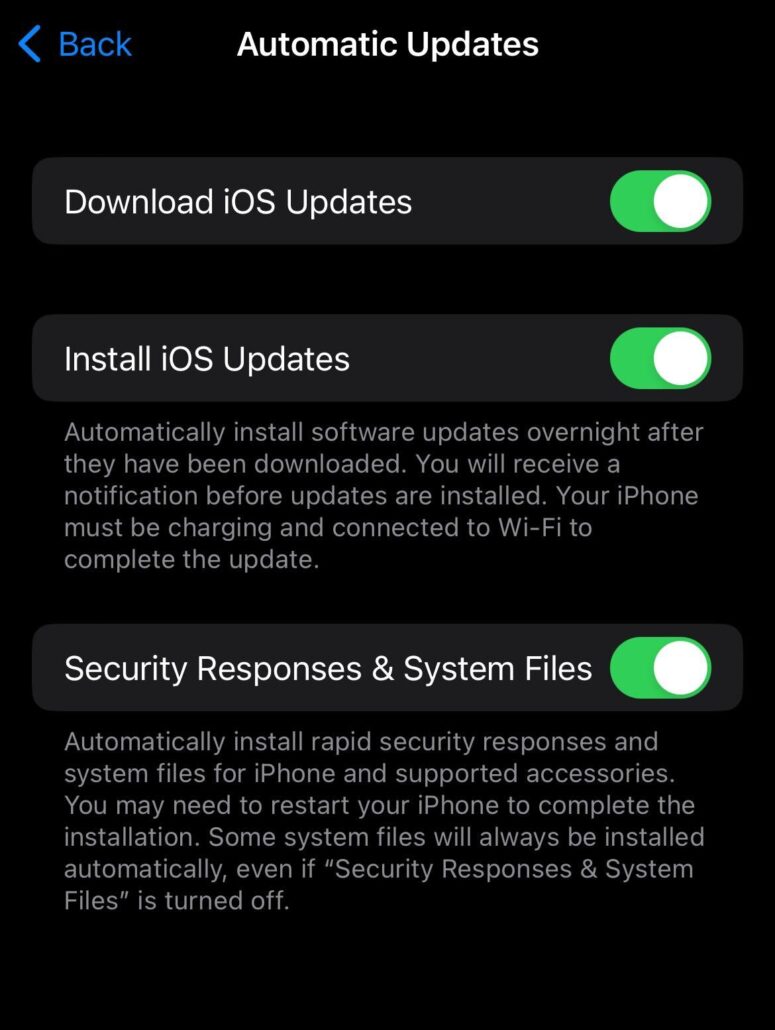
May 22: 3 New Vulns | CVE-2023-32373, CVE-2023-32409, CVE-2023-28204
In this CISA KEV Breakdown, three zero-days reported to Apple just last week have been added to the Known Exploited Vulnerabilities catalog. Currently, little information exists as to the nature of exploitation activity related to these vulnerabilities, with their addition to the KEV being due to the fact that Apple indicated the vulnerabilities may have been exploited in their security advisory. In last week’s Breakdown post, we referenced Google TAG’s 0-day “In the Wild” spreadsheet which tracks active 0-days by year. All three CVEs added to the KEV appeared in this datasheet as early as last week.
Users, especially those that can be considered high-risk, are encouraged to enable Apple’s new feature “Rapid Security Updates.” This feature allows for Apple to push automatic updates to your device that relate to immediate security issues disclosed to or discovered by Apple. Users can enable the feature in Settings > General > Software Update > Automatic Updates.

Apple will note when a Rapid Security update was released for your device with a versioning letter appended to the end of your device’s current version. For example, CVE-2023-32373 and CVE-2023-32409 were patched for iOS 16.4.1 (a) and iPadOS 16.4.1 (a).
CVE ID | Vendor/Project | Software | Exploitation Consequence | GreyNoise Traffic | EPSS Score | EPSS Percentile | Due Date |
CVE-2023-32373 | Apple | iOS, iPadOS, tvOS, watchOS, macOS Ventura, Safari | Code Execution | 06/12/2023 | |||
CVE-2023-32409 | Apple | iOS, iPadOS, tvOS, watchOS, macOS Ventura, Safari | Sandbox Escape | 06/12/2023 | |||
CVE-2023-28204 | Apple | iOS, iPadOS, tvOS, watchOS, macOS Ventura, Safari | Information Disclosure | 06/12/2023 |
Notable Vulnerability Additions
CVE-2023-32373, CVE-2023-32409, CVE-2023-28204 | Apple WebKit 0-days
CVE-2023-32373 is a vulnerability in WebKit that allows an attacker to execute arbitrary code upon convincing the victim user to interact with maliciously hosted content. Apple indicates the vulnerability was remediated with improved memory management. CVE-2023-32409 is a sandbox escape vulnerability in WebKit that can allow an attacker to execute arbitrary code outside of the Web Content sandbox. This vulnerability also requires user interaction. CVE-2023-28204 is an out-of-bounds read vulnerability that, upon exploitation, allows for an attacker to disclose sensitive information. The exploitation of CVE-2023-28204 and the sensitive information that is disclosed is not clear at this time.
All three vulnerabilities affect the following Apple technologies and versions: iOS, iPadOS, and Safari versions 16.4.1 and earlier, watchOS versions 9.4 and earlier, tvOS versions 16.4 and earlier, macOS Ventura versions 13.3.1 and earlier.
Security Advisory(s):
https://support.apple.com/HT213757, https://support.apple.com/HT213758, https://support.apple.com/HT213761, https://support.apple.com/HT213762, https://support.apple.com/HT213764, https://support.apple.com/HT213765
← May 19, 2023 CISA Kev Breakdown
Click here to expand our CISA KEV Breakdown Frequently Asked Questions
- What makes for a notable addition?
- A notable addition can arise from many different characteristics. If a particular vulnerability is notable to the security community or a subset of the security community or if the EPSS score reveals notable information about the vulnerability, this can constitute further analysis. It may also be the case that a particular vulnerability shines a light on everyday users and we will highlight important information and key takeaways to ensure users and readers have easy access to actionable information.
- When is the Breakdown released?
- We aim to have our analysis of each KEV update posted within 24 hours of the time in which the Catalog is updated. See CISA’s full catalog here
- I am not bound by BOD 22-01 or federal regulations, why should the KEV concern me?
- CISA encourages all organizations to utilize the Catalog as an attribute in your vulnerability prioritization framework. Organizations looking to lessen the scope on known dangerous vulnerabilities and make a goal to remediate them can understand where they currently stand against what CISA has confirmed as exploited vulnerabilities in the wild. See CISA’s section on “How should organizations use the KEV catalog?” here.
- What is EPSS?
- EPSS is the Exploit Prediction Scoring System. It is an open, data-driven effort for estimating the likelihood (probability) that a software vulnerability will be exploited in the wild. See the EPSS home page on FIRST for more information here.
- What is the difference between EPSS probability and EPSS percent?
- EPSS probability is the risk calculated by the model when determining the perceived threat of the vulnerability itself. Percentage is a relative comparison of the rest of the CVEs within the given sample. While the probability only changes upon refreshing the results from the model, the percentage can change purely based on the CVE sample given. In the case of the Breakdown, we use the percentage given by the pool of all CVEs with given EPSS data. Scores may vary post-release of the post given new information about the vulnerabilities and their perceived threat. For more information on applying and understanding EPSS data, see this article on the FIRST website, as well as their FAQ page.
- What is GreyNoise?
- GreyNoise is a platform that collects, analyzes, and labels data on IPs that scan the internet and saturate security tools with noise. Through their sensor network, GreyNoise observes vulnerability exploitation attempts for vulnerabilities that are exploited in the wild over the Internet. These are arguably vulnerabilities that should be at the very top of your priority list to remediate.
- Why are GreyNoise exploitation attempts only observed on ~20% of KEV vulnerabilities?
- Exploitation of many vulnerabilities in the CISA KEV will not be observed for many reasons that GreyNoise does a good job of explaining in this post. For example:
- The vulnerability may not be remotely exploitable
- Vulnerability exploitation may require authentication (and result in privilege escalation)
- The impacted software may not be exposed to the internet
- Mass scanning/exploitation is not occurring yet
- Exploitation of many vulnerabilities in the CISA KEV will not be observed for many reasons that GreyNoise does a good job of explaining in this post. For example:
